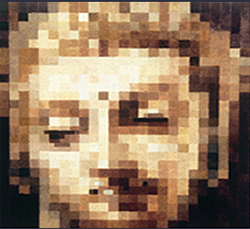
Gandhara Media Coverage
Gandhara centre seeks to revive Taxila's history as Buddhist centre of learning.
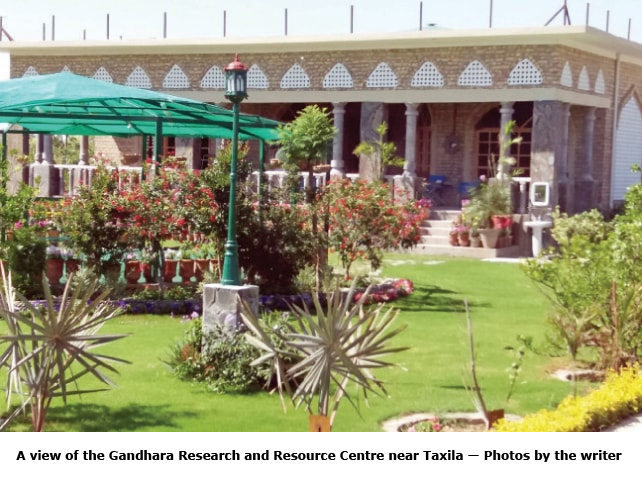 TAXILA: Modern day Taxila was once the cradle of the Gandhara civilisation, famous as a centre of learning for sculpture and art, architecture, education, medicine and religion, and home to one of the oldest recognised universities in the world.
TAXILA: Modern day Taxila was once the cradle of the Gandhara civilisation, famous as a centre of learning for sculpture and art, architecture, education, medicine and religion, and home to one of the oldest recognised universities in the world.
According to experts on Gandhara’s history, there were at one stage more than 10,000 students from Babylon, Greece, Syria and China learning languages, Vedas, philosophy, medicine, politics, warfare, accounts, commerce, documentation, music, dance and other performing arts, futurology, the occult, science and mathematics from monks, until the city was destroyed in the 5th century.
Students enrolled at Taxila university, now known Julian monastery, at the age of 16 and were taught in different faculties according to their intellectual ability, interests and capability. They were even taught archery, hunting and elephant lore, along with law, medicine and military science.
Panini, the great Sanskirt grammarian and author of a famous book on Sanskrit grammar used to teach here, while Ashtadhyayi lived and taught at Taxila university.
Charaka, the physician considered the father of Indian medicine because of his contribution to the development of Ayurveda, was also an alumnus.
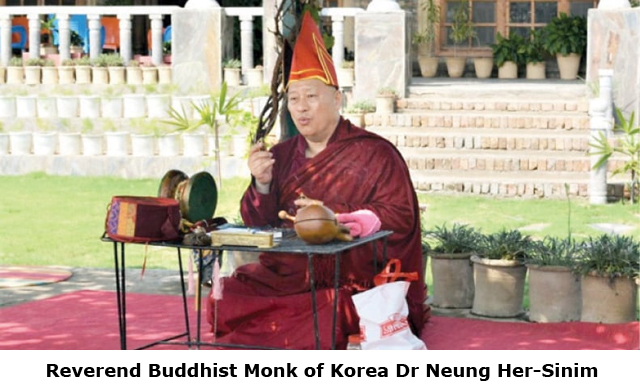
The most influential teacher from the university was Acharya Chanakya, also known as Kautilya, the legendary political philosopher, thinker and royal adviser.
Now, the Gandhara Research and Resource Centre has been established in a lush valley between the two ancient sites of Sirkap and Julian in a bid to revive Taxila’s history as a Buddhist centre of learning.
Dr Neung Her-Sinim, the reverend Buddhist monk of Korea, has joined as the first scholar in residence at the centre. Dr Sinim has examined and treated a number of people using his certified knowledge of alternative medicine as part of the centre’s clinical services.
The centre has been established, near the ancient Julian University, to rekindle the area’s ancient reservoirs of spiritual energy through research, meditation and healing.
“The place I am serving as scholar in residence was once an embodiment of the ancient Buddhist region,” Dr Sinim told Dawn. He said: “I have arranged many prayer and meditation sessions, as well as healing the ailing community with traditional Chinese medicine.”
Gandhara Art and Culture Association General Secretary Dr Park Kyo Soon, who supervises the centre, said as an expert in traditional Chinese medicine including acupuncture, tai chi and herbal products, Dr Sinim will contribute to the centre’s research programme in alternative medicine, hold meditation sessions and run a clinical practice that will particularly benefit the local population of Taxila.
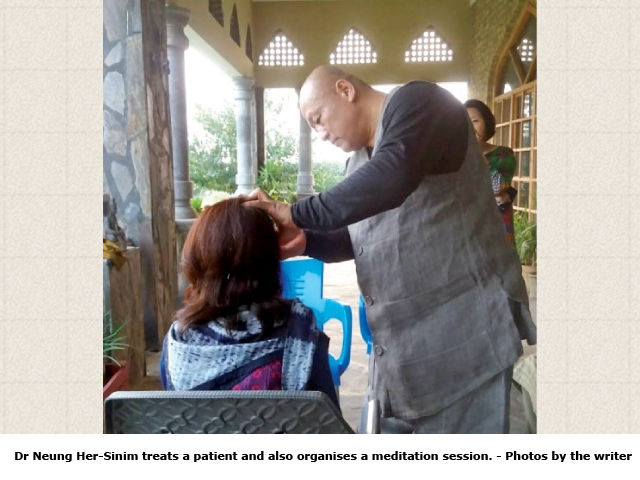
She said the reverend monk had undertaken a spiritual journey of Gandhara sites including Takht Bhai, Swat and Bhamala in Khyber Pakhtunkhwa to spread the message of peace.
He found this area to be the best possible spiritual location in the region because it was the crossroads of the ancient Silk Road from Afghanistan to China and Buddhism flourished across the world from this route, she said.
“There are more than 50 archaeological sites scattered in a 30 kilometre radius around Taxila valley. The place where I strive to revive this ancient centre of Gandhara research and resource is the centre point of these ancient places,” scholar Ayaz Kiyani, the organiser of the centre, said.
Published in Dawn, November 10, 2019. : Click to view
--------------------------------------------------------
Organized prayer ceremony for the peace of kashmir and world peace at Bhamala stupa Date: October 17, 2019
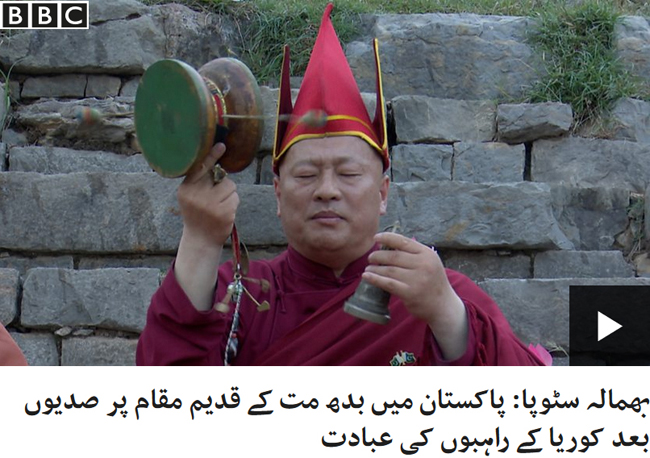
 Published in BBC, October 19th, 2019. : Click to view
Published in BBC, October 19th, 2019. : Click to view
--------------------------------------------------------
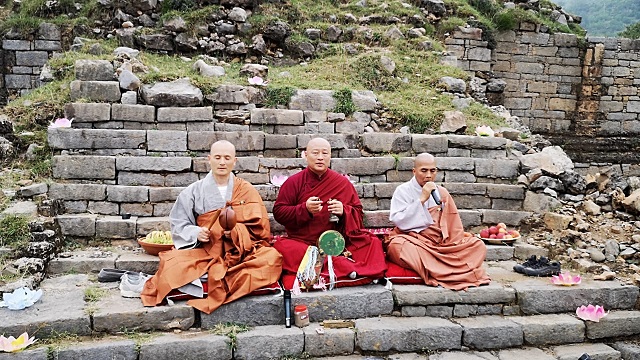
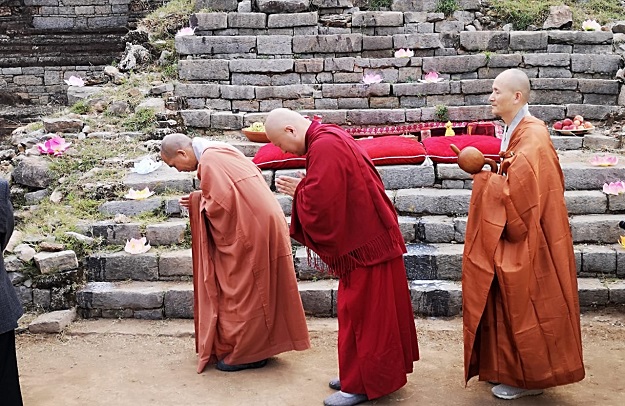
--------------------------------------------------------
Buddhist rituals performed at ancient stupa after nearly 2,000 years.
TAXILA: Buddhist rituals were performed for the first time in two millennia at the ancient Bhamala Monastery and Stupa on Friday, when Korean Buddhist monks prayed for peace in South Asia, the birthplace of Buddhism, and the world.
This was the first religious service held at Bhamala, which dates back to the 2nd century AD. The ceremony was organised by the Gandhara Art and Culture Association, the Centre for Culture and Development and the Khyber Pakhtunkhwa Directorate of Archaeology and Museums.
The prayer ceremony was attended by civil society members and people from a variety of religious backgrounds from across the world, including from the diplomatic community.
Bhamala has its own significance and importance in Gandhara civilisation, as the largest statue ever found in Gandhara depicting the death of Buddha was discovered here.
The statue, discovered in 2016, is 1,700 years old and 48 feet long. It was found alongside a double-halo Buddha statue, the first of its kind found in the history of the Buddhist civilisation in Pakistan.
The site was reduced to ruins for almost 2,000 years after the White Huns destroyed it in the 5th century AD. It saw only occasional visitors until Friday, when three Korean monks, Dr Neung H. Sinim, Jeok Kyung and Jeong Wei prayed there for peace and stability.
Gandhara Art and Culture Association General Secretary Dr Park Kyo Soon told the media that traditional Buddhist prayers were offered at the stupa around 2,000 years after the decline of Buddhism in the region.
She said Korean monks have joined hands with their Pakistani counterparts for the revival of Takhshila University. They are striving to rekindle the ancient reservoirs of spiritual energy through research, meditationand healing, she said.
She added that, being an expert in traditional Chinese medicine such as acupuncture, tai chi and herbal products, Dr Sinim would contribute his services for alternative medicine, hold meditation sessions and run a clinical practice to benefit Pakistanis.
Archaeology and Museums Director Dr Abdul Samad said the Bhamala Stupa is located on the ancient silk route. It resembles Aztec pyramids, he said, and this kind of construction has only previously been found in Kashmir. In addition to the main stupa, there are around 19 small votive stupas in the surrounding courtyard constructed using the diaper masonry technique.
Dr Samad said the KP government has allocated Rs1 billion to promote religious tourism in the province. He said the chief monk of Thailand is expected to visit ancient sites in Pakistan next month.
Published in Dawn, October 19th, 2019. : Click to view
--------------------------------------------------------
GACA korean member Prof Dr So gave a important suggestion for historical cultural union sub-continent through In du river civilization.
 Hyecho was a Buddhist monk from Silla, which is part of present-day Korea. He set out for present-day Pakistan in the early eighth century to see the culture and land of the Buddha.
Hyecho was a Buddhist monk from Silla, which is part of present-day Korea. He set out for present-day Pakistan in the early eighth century to see the culture and land of the Buddha.
During his travels, he wrote a book in old Chinese about the five kingdoms of Indu, which are also referred to as Tentouk. Head of the Pure Land Buddhist Institute Dr So Gilsu re-traced Hyecho's footsteps almost 1,300 years later. He is a former professor of economic history and is one of the few people who can read ancient Chinese scripts.
Dawn caught up with Dr So Gilsu to talk about the cultural and historical linkage between Pakistan and Korea.
Q: Why did Hyecho undertake the journey from present-day Korea to the present-day Indian Subcontinent (Pakistan)?
A: Hyecho was searching for Dharma, which in Sanskrit means The Truth. So, the monk was searching for the truth. The truth was in this region, not there. That is why he travelled all the way to present-day Pakistan in search of it.
But how did he know he was going to find the truth here? Teachings from this place in geography, which was referred to as Indu or Tentouk and which comprised of present-day Pakistan, India and Bangladesh, were very common in the Korean peninsula and China. North and west Tentouk comprise Pakistan today, central and south Tentouk are what is modern-day India and east Tentouk is now Bangladesh.
Teachings from here were already translated into Chinese there. Hyecho came here and took a lot of Sutras, or manuscripts and translated them into Chinese. But he never got back home and died during his travels in China. The truth that he was looking for still exists here.
I came from Korea to here on the same route that Hyecho took and visiting the same places he visited took me a month even though I took all modern modes of transport. It took him a year to undertake the same journey. What difficulties he must have faced. Surely our experiences cannot be the same. But, like Hyecho, I also come with the message of peace and love.
Q: What did you learn from your travels to Pakistan?
A: I find immense tourism opportunities here, especially of religious tourism. Pakistan is a wonderful country with so many places that are culturally and religiously significant to many people, especially for Buddhists.
If these places are well preserved and looked after and tourist safety is ensured, Pakistan can earn immensely from tourism and this can also be an opportunity to properly present itself to the world as the wonderful country that it is.
This will also lead to further improvement in relations with other countries. For example, South Korea and Pakistan enjoy friendly relations. We can increase people-to-people contact by Korea opening its employment market to Pakistan and the latter taking care of and promoting the Buddhist history here so that more Koreans can visit.
At one point, there were 13,000 Buddhist temples in the Swat area which have since been destroyed or damaged and very few such places remain but that too in deplorable conditions.
Q: How can the history here be promoted more effectively?
A: I have always suggested a cultural union in the Tentouk region since it has the same history and culture, but again, that is just my opinion.
This region can be the biggest tourist market of the world. Just in Pakistan you have the Indus Civilisation and the Mahayana Buddhist sites, including in the Swat Valley which millions want to visit, especially Koreans. Malananda, the first monk to bring Buddhism to southern Korea in the fourth century was also from Gandhara. This potential should be tapped on with a proper plan.
Published in Dawn, October 11th, 2018 : Click to view
--------------------------------------------------------
Footsteps of a Korean Monk in Pakistan in the 8th Century
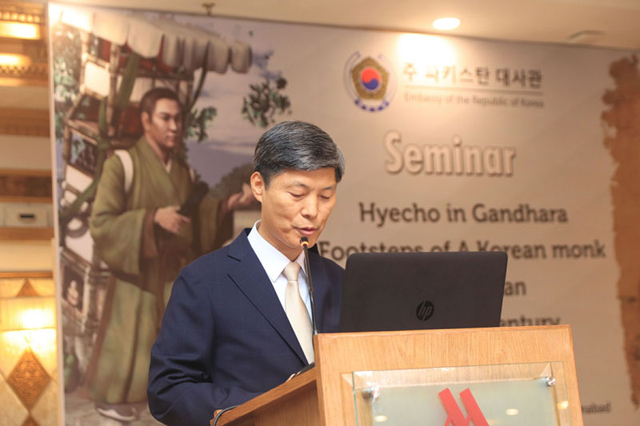
Seminar on Hyecho in Gandhara,Naveed Ahmad Khan
A Seminar titled "Hyecho in Gandhara: Footsteps of a Korean monk in the 8th Century" was held on Thursday. The seminar organized by the Embassy of the Republic of Korea highlighted the historical and cultural linkages between the Korean and Pakistani people centuries ago.
Chief Guest at the event was Aamir Hasan, Federal Secretary National History and Literary Heritage Division. Hasan highlighted the role of the Division in increasing Korea-Pakistan cultural ties. Mr. Shahid Zaman, Secretary of Tourism and Culture Department, Khyber Pakhtunkhwa was also present at the occasion. Government officials, dignitaries, students and history enthusiastsattended the seminar.
On the occasion Mr. Kwak Sung-kyu, Ambassador of the Republic of Korea introduced "co-project for preservation and treatment of cultural relics" which is progressing between the Korean and the Pakistan governments. He also committed and offered to further work together, on the federal or provincial government level, to enhance the cultural interactions and people-to-people exchanges in the coming days.
Three eminent scholars including Dr. Muhammad Farooq Swati, Dr. Esther Park and Dr. So Gilsu made presentations at the seminar, shedding light on the travelogue of the Korean monk Heycho who travelled around Pakistan in the 8th century. The scholars also highlighted the impact of these early travels on the spread of Buddhism in the Korean peninsula and around the world. Dr. Swati presented insights into the importance of the Khyber Pakhtunkhwa region as a historical melting pot for cultures, traditions, art work and architecture. Dr. Park spoke about the memoirs of Heycho titled "Memoir of the pilgrimage to the five kingdoms of India" which is one of the earliest recorded travelogues to vividly describe many areas of Pakistan in the 8th century. Dr. Park also suggested taking steps for increasing Korean Buddhist touriststo Pakistan. Dr. So spoke about his recent travels across China and Pakistan during which he followed the ancient routes taken by the Korean monk Heycho.
The audience also watched the classical Korean "Sunbi Dance" performance by Dr. Han Young Yong. Sunbi refers to academia in Josun dynasty, who focused on studying with neither any official position nor rewards.
Published in Pakistan Observer, October 5, 2018. : Click to view
--------------------------------------------------------
Korean who retraced 1,300-year-old journey has a message for today
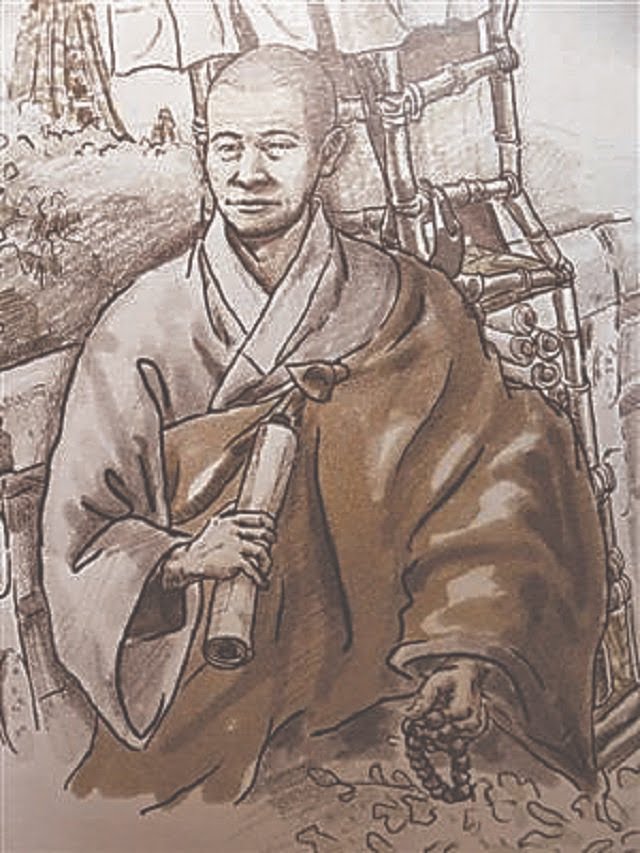
ISLAMABAD: A South Korean historian and economist has called for creating a European Union-style union in the subcontinent which traces its roots to the thousands of years of shared history.
This was urged by Dr So Gilsu, a South Korean scholar who heads the Pure Land Buddhist Institute while speaking a seminar organised by the South Korean Embassy in the federal capital last week.
Dr Gilsu is visiting archaeological sites in Pakistan in a bid to trace the footsteps of the Korean monk Hyecho, who had visited areas in modern-day Pakistan and India during the Gandhara civilization and later wrote about it in his ‘Memoir of the Pilgrimage to the Five Kingdoms of Tentouk (Sindhu)'.
"Hyecho set out for Tentouk (Indu-ia) in 723 AD to acquaint himself with the language and Dharma of the land of Buddha," said Dr Gilsu.
Tracing the ancient link between Gandhara and Korea, Dr Gilsu said that the first Buddhist missionary from Gandhara who traveled to Korea was Malananda in the fourth century.
"Malananda was a Buddhist monk from Gandhara - modern-day Pakistan, who brought Buddhism to southern Korea in the fourth century. He came to Baekje from Jin China in 384 AD," the South Korean scholar explained.
Bop-song-po (The Habour of Holy Dharma), located in the southwest of Korea, thus became the first hub for Buddhism in the Korean peninsula through Malananda, he added.
Dr Gilsu elaborated that little to nothing is known about the route which Malananda took.
However, Hyecho wrote detailed memoirs of his journey in Chinese called Wang o-chonchukguk-jon. This translates to as 'Memoir of the Pilgrimage to the Five Kingdoms of Tentouk (indu-ia)'.
Parts of Hyecho's book were discovered by Paul Pelliot, a French sinologist, in the 20th century. Pelliot collected Hyecho’s book and a host of other manuscripts in different languages which now lie in the National Library in Paris.
In the book, the region was named Tentouk, which Dr Gilsu says means the 'Sindhu River'.
He elaborated that there were five kingdoms of Tentouk: north, west, central, south, and east Tentouk. Dr Gilsu said that North and West Tentouk are mainly the areas which comprise Pakistan today, while central and south Tentouk lie in modern-day India and East Tentouk is Bangladesh.
Hyecho visited West Tentouk, which is the Sindh province today. There is also mention of Kashmir, Skardu, Gilgit, Swat, Chitral and Gandhara in Hyecho's book.
Dr Gilsu says 'Indus' and 'India' are the names given by Europeans while the root for both these names is Indu or the Indu River.
After tracing Hyecho's footsteps in Pakistan, Dr Gilsu hopes to continue his research in India and then on to Bangladesh.
"It took me a month to travel by road from China to Islamabad. But 1,300 years ago, it had taken Hyecho an entire year to travel from Gandhara to China where he lived and died," Dr Gilsu said.
"You can call me the modern Hyecho and I come with the message of peace and harmony in the whole of Indu," he enthused.
"Since the partition of British India in 1947 and creation of modern states of India and Pakistan, the two countries have been involved in four wars. The wars and conflict have ended with defeat or disaster for both countries," the scholar said, adding, "I know the fact well since I myself experienced the same history in my country, Korea."
Published in The Express Tribune, October 8th, 2018.
--------------------------------------------------------
간다라 불상이 전하는 특별한 감동
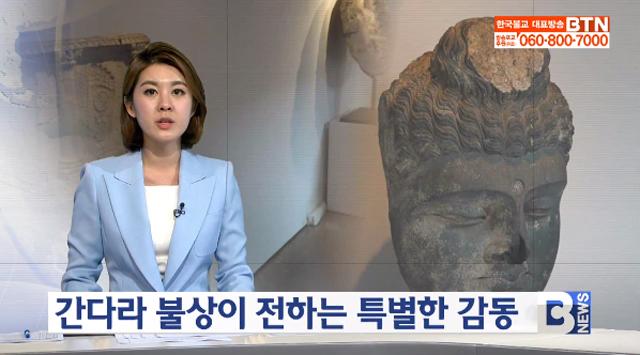
불교예술의 도상학적 기원이 된 간다라 미술은 알렉산더 대왕의 동방원정과 함께 동서양 융합문화의 가장 성공적인 사례로 평가받는데요. 기원전 2세기경에 만들어진 간다라양식의 최초 불상을 만나볼 수 있는 전시회가 열려 주목받고 있습니다. 간다라불상이 전하는 평화와 공존의 세계로 떠나보시죠. 이동근 기잡니다.
불교예술의 꽃인 불상의 시초이자 동서양 문화의 교집합을 이뤄낸 간다라 미술.
알렉산더 대왕의 동방원정을 통해 탄생한 간다라 양식은 그리스문명의 영향으로 최초의 불상을 조성하는 역사를 만듭니다.
서울 안국동의 한 갤러리에서 2~3세기경에 조성된 간다라 불상을 만나볼 수 있는 이색 전시회가 열렸습니다.
전시장은 ‘미소로 나투신 부처님’을 주제로 유구한 역사와 다양한 형태를 지닌 유물들로 가득합니다.
다소 투박해 보이지만 신비로움이 물씬 풍기는 ‘불두’를 비롯해 대승불교 사상이 응축된 ‘기적을 일으키는 부처’, 정신적 구제의 힘을 강조한 부처님 입상과 보살상 등이 눈길을 끕니다.
더불어 진리의 상징인 수레바퀴와 청정한 영혼을 나타내는 연꽃 등 화려한 문양들을 새겨 넣은 ‘부처님 발자국’에서 영원불멸의 의미도 엿볼 수 있습니다.
int-이경은 / 갤러리 아트링크 대표
(동서양의 문화가 서로 융합되면서 부처님도 인간의 모습으로 표현하게 됩니다. 그리고 당시의 복장과 장신구들을 여실하게 보여주고 있는데요. 그것이 전래되면서 보살상의 여러 가지 장식과 장신구들의 원형을 이루고 있습니다.)
이번 전시는 찬란했던 불상의 역사를 관람객에게 심어주는 남다른 의의를 지니고 있습니다.
당시 간다라 지역에서 활동했던 예술가들의 고민과 흔적이 보살상의 원형으로 피어나 불교에 대한 심도 있는 의미를 마주할 수 있습니다.
또, 그동안 전해진 한국고유의 불상을 떠올리며 간다라 불상과 비교해가는 일은 전시회의 또 숨은 재미이기도 합니다.
int-이경은 / 갤러리 아트링크 대표
(대승불교와 함께 동쪽으로 중국과 한국, 일본까지 이르는 불교미술 도상의 원형이 되어서 공존과 화합의 이미지를 간다라불상에서 찾아볼 수 있으면 합니다.)
온화한 미소와 함께 평화의 메시지를 전하고 있는 상징적 유물, 간다라 불상.
불상의 시초를 감상할 수 있는 전시는 서울 안국동 갤러리 아트링크에서 이번 달 31일까지 이어집니다.
BTN 뉴스 이동근입니다.
이동근 기자 btnnews@btn.co.kr
Source : http://www.btnnews.tv/news/articleView.html?idxno=48713
--------------------------------------------------------
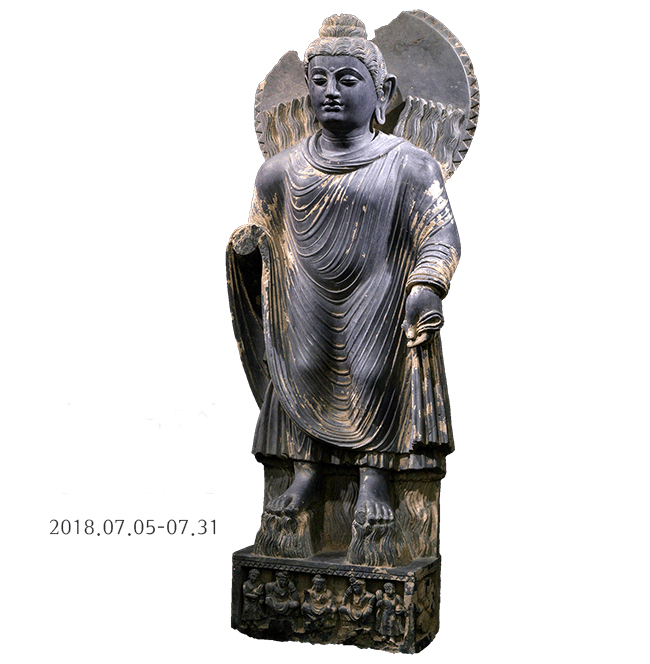
Source : http://www.interartchannel.com/bbs/board.php?bo_table=bbs_01&wr_id=116
--------------------------------------------------------
Gandhara artefacts fair aimed at fetching tourists. (Published in The Nation)
A three-month-long Gandhara antiquities exhibition that was held in Seoul Korea aimed not only to promote the soft image of Pakistan but also help fetch religious Buddhist tourists to Pakistan, Secretary-General Gandhara Art and Culture Association Dr Kyo Soon Park said while talking to media at Taxila Museum on Sunday.
He said that the exhibition was a landmark event in highlighting cultural relations between Pakistan and Korea.
The three-month long exhibition titled “The rise of Gandhara” of 40 artifacts from Peshawar Museum was organized by the Gandhara Art and Culture Association and the Korean Inter Art Channel in collaboration with Khyber-Pakhtunkhwa (K-P) Directorate of Archaeology and Museums and the Ministry of Cultural Heritage Pakistan, supported by Korean embassy in Pakistan. According to Dr Park, the exhibition and all the artifacts presented in Seoul from Pakistan brought a message of globalization that took place in 384 AD when Monk Maranatha from the city of Swabi visited Korea and spread Buddhism there which still endures to this day.
She was of the view that the exhibition will help attract international religious tourists as the rich archaeological treasure trove of the Gandhara Civilization was showcased at the exhibition. Dr Park said that “we have many ideas to promote Gandhara in the world. For example, we made for the first time digital hologram of the ‘Fasting Buddha’ and showed it during the exhibition in Korea. Being a digital period, this is the best way to show to the world that Pakistan possesses such a great masterpiece of art and also send a message of peace to the world in a current trendy way.”
She said that the evidence was that the exhibition attracted a lot of children and students. “We are now using this material in schools for teaching purposes. Similarly, we can make holograms of important Gandhara sites and objects for promotional and educational purposes,” she said.
“Since most of Gandhara Buddhist heritage sites are lying in Pakistan, we can make a ‘Mecca for Buddhists’ in this region. For this, the KP government is already very active, so if we work together with private sector and the KP government, we will achieve a lot for this purpose,” she said.
Dr Parker was of the view that the Korean monk Hyecho came to Gandhara in 726 AD for pilgrimage and left very precious memoir about the Gandhara region, and also famous Chinese monk Xuan Zang came here in the 7th century.
“Therefore, in this 21st century, we can revive the pilgrimage link between Pakistan, China, and Korea similar to the CPEC project which will boost religious tourism,” she said
“The aim behind the exhibition of Gandhara artifacts is to show the world that Pakistan has great religious tolerance and Buddhist religious places in the region are safe and there is no threat to them.” She said that the Gandhara Art and Culture Association also organized a photographic Gandhara art exhibition in Seoul in 2011 and now the Gandhara artifacts exhibition in 2017 to present the Buddhist historical legacy to the Korean people. Answering a question, she said that the KP government was very supportive in holding the exhibition.
Director KP Directorate of Archaeology and Museums Dr Abdul Sammad said that 40 artifacts belonging to the ancient Gandhara Civilization were temporarily exported to Korea and have now been returned safely and are already put back on display at the Peshawar Museum.
Dr Samad said that exhibition will also help in attracting donations for further archaeological excavations and the preservation of archaeological sites.
Published in The Nation, December 04, 2017 :
Click to view
--------------------------------------------------------
'동서문화 융합의 상징'..간다라 유물 한국에 오다
알렉산더 대왕의 동방원정으로 탄생한 간다라 미술은 동서양 문화 융합의 상징으로 평가받고 있는데요.
간다라 유물을 가장 많이 소장하고 있는 파키스탄 페샤와르 박물관의 귀중한 문화재가 우리나라에 왔습니다.
'알렉산더 대왕이 만난 붓다전' 이란의 크리스틴 국민기자가 다녀왔습니다.
그리스 신상과 불상이 같은 포즈를 하고 있습니다.
동서양의 두 문화의 융합을 상징적으로 보여줍니다.
김양수 대표 / 인터아트채널
“손을 이렇게 하고 있는 것이 너무나 같지 않습니까? 결과적으로 이것이 가장 대표적이고 우리가 증거로 볼 수 있는, 서양과 동양이 융합을 해서 불상의 탄생이 되어왔다는 것을 볼 수 있는 것이죠.”
신을 인간의 형상으로 표현한 그리스, 로마의 예술 기법이 동양의 불교와 만나 입체적인 옷과 주름, 손의 모양을 한 간다라 불상으로 재탄생했음을 보여줍니다.
파키스탄의 국보 '고행상'은 세계 최초로 VR과 홀로그램으로 제작됐습니다.
석가모니 부처님의 고행 모습을 실물보다 더 현실감 나게 표현했습니다.
간다라 미술 중에서도 최고 걸작으로 평가되는 이 고행상은 가상현실 속에서 직접 보고 만질 수 있도록 했습니다.
간다라 유물을 가장 많이 소장하고 있는 파키스탄 국립페샤와르 박물관의 유물 67점이 한국을 찾았습니다.
인터뷰> 라힘 하야트 쿠레쉬 / 주한 파키스탄 대사
“붓다 예술 조각상이 파키스탄에서 한국으로 왔습니다. 많은 한국사람들이 작품을 보고 이를 계기로 두 나라 관계가 더 깊어지고 교류도 활발해질 것으로 기대합니다.”
간다라 미술에는 알렉산더 대왕의 문화 정신이 담겨있습니다.
동방원정에 나선 알렉산더 대왕은 그리스 문화와 각 지역의 문화를 융합시킨 '헬레니즘' 문명과 동·서 문화의 교류와 융합으로 이뤄진 새로운 예술 양식 '간다라 미술'을 만들어냈습니다.
이번 전시는 2천 년 전 간다라 유물을 인류역사상 가장 성공적이었던 인종과 문화, 종교 간 화합의 하모니를 보여주고 있습니다.
2,000여 년 전 파키스탄은 다문화, 다종교, 다인종의 공존으로 가장 번영하고 평화로웠던 시대를 누렸던 곳입니다.
동서양 화합과 평화의 상징인 간다라 유물들은 현재 세계 곳곳에서 일어나고 있는 국제적 갈등에 대한 해법을 제시하고 있습니다.
인터뷰> 정재민 회장 / 한문화진흥협회
“평화와 화합의 의미를 다시 한번 생각하는 계기가 되고 파키스탄의 문화에 대한 이해를 통해서 양국 간의 우호 증진에 기여하는 전시가 되길 희망합니다.”
동·서양 문화융합의 결정체인 간다라 미술의 시대적 가치를 살펴볼 수 있는 알렉산더 대왕이 만난 붓다 전은 9월 말까지 계속됩니다.
국민리포트 크리스틴입니다.
( KTV 국민방송 케이블방송, 위성방송 ch161, www.ktv.go.kr
Click to view more detail
--------------------------------------------------------
김양수 “응당 꼭 해야 하는 일이 있어요 간다라展이 제겐 그렇습니다”
“눈뜨고 일어나서 밥 먹는 것처럼, 응당 꼭 해야만 하는 일이 있어요. ‘간다라 미술전’은 내게 그런 전시입니다.”
김양수 인터아트채널 대표(67)는 40여 년간 국내외 전시를 기획해 온 미술계 원로다. 미디어아트의 선구자 백남준의 1990년대 미국 생활을 지켜본 가까운 지인이기도 하다. 백남준 탄생 85주년이 되는 20일 ‘간다라 미술전’이 열리고 있는 서울 서초구 예술의전당 서예박물관에서 그를 만났다.
서울대 미대 출신인 김 대표는 1990년대 중반 미국으로 이주해 화랑을 운영했다. 당시 그는 백남준과 뉴욕 소호 지역에 이웃해 살며 자주 왕래했다. 브루클린 미술관에 소장된 백남준의 작품 ‘경기 따라지’(1997년)의 모델이 되기도 했다.
그는 ‘꼭 해야만 한다’는 사명감을 주는 전시가 몇 개 있다고 했다. 1992년 백남준의 국내 첫 회고전 ‘비디오 때, 비디오 땅’, 1993년 ‘아, 고구려’전, 2015년 개성 만월대에서 남북 학자들이 공동으로 발굴한 유물 전시가 그랬다. 이번 간다라 미술전도 그의 버킷리스트 중 하나였다.
“2000년 전 동방 원정을 떠난 알렉산더 대왕의 ‘침략했지만 파괴하지 않는다’는 철학 덕분에 간다라 지역엔 다양한 종교, 문화, 인종을 온전히 수용하는 독특한 예술 문화가 나타날 수 있었죠. 이번 전시의 핵심이기도 합니다.”
실제 간다라의 부처 입상은 비슷한 시기 로마시대 소포클레스 신상과 비교해 자세와 옷 주름, 실루엣 등에서 놀라울 정도로 비슷하다. 간다라 미술의 최고 걸작으로 평가받는 앙상한 갈비뼈의 싯다르타 고행상도 가상현실(VR) 기술을 활용해 전시하고 있다. 이번 전시를 만들기 위해 파키스탄 페샤와르 박물관에서 소장품을 빌려왔다. 설득하고 준비하는 기간만 3년이 걸렸다.
알렉산더 대왕의 정신을 담은 유물을 소장한 파키스탄과 아프가니스탄 등은 현재 아이러니하게도 종교와 인종 문제로 분쟁 중이다. 전시 말미에 지구 반대편에서 ‘다르다’는 이유로 벌어지는 갈등을 다룬 VCR도 상영된다.
김 대표는 “융합, 공존, 포용과 같은 간다라 미술의 정신이야말로 요즘 시대에 필요한 가치”라며 “이번 전시가 1시간 동안 재미있는 영화를 보고 나온 느낌을 줄 수 있기를 바란다”라고 말했다.
조윤경 기자 yunique@donga.com
Click to view more detail
--------------------------------------------------------
서울 관문사, 카니시카왕 사리함 이운 및 친견법회
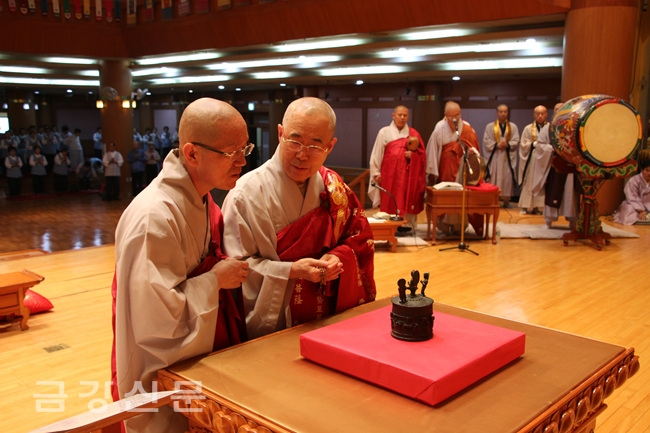
고대 인도 쿠샨 왕조 최성기의 왕이었던 카니시카왕(재위 130~155년)이 부처님 진신사리를 보관하기 위해 만든 사리함을 직접 친견할 수 있는 법석이 마련됐다.
서울 관문사(주지 춘광 스님ㆍ천태종 총무원장)는 6월 25일 오전 8시 4층 옥불보전에서 ‘카니시카왕 사리함 이운 및 친견법회’를 봉행했다. 법회에는 춘광 스님을 비롯해 천태종 총무부장 월도 스님, 김양수 인터아트채널 대표 등 사부대중 800여 명이 참석했다.
이운 의식에 이어 봉행된 친견법회에서 총무원장 춘광 스님은 법어를 통해 “오늘 친견하는 ‘카니시카왕 사리함’은 멀리 파키스탄의 페샤와르 박물관으로부터 우리 관문사에 이운해 왔다.”면서 “이 사리함은 간다라 미술의 많은 걸작 중에서도 걸작으로 꼽히는 귀한 유물”이라고 설명했다.
이어 춘광 스님은 “카니시카왕은 사리함의 뚜껑에 ‘모든 생명의 이익과 행복을 위해 사리함을 만들어 봉안한다.’고 기록해 놨다.”며 “2000년 전의 뜨거운 불심을 2000년 후의 우리들이 오늘 친견하고 만나는 것이다. 오늘 친견을 통해 여러분은 사리함만 보실 것이 아니라 사리함에 담긴 염원과 불심을 보고 느끼길 바란다.”고 당부했다.
앞서 천태종 총무부장 월도 스님은 개식사에서 “‘카니시카왕 사리함’은 카니시카왕이 부처님 진신사리를 모시기 위해 만들었다. 이런 성물이 관문사에 온 것은 우리에게 큰 인연”이라며 “카니시카왕은 처음부터 불자는 아니었지만 대제국을 건설하면서 점차 부처님 가르침에 빠져들었다. 불심으로 제작된 이 사리함을 친견함으로써 여러분들의 모든 업이 소멸되길 기원한다.”고 말했다.
이번 ‘카니시카왕 사리함’은 6월 28일까지 관문사 4층 옥불보전에서 만나볼 수 있다. 이후 9월 30일까지 예술의전당 서울서예박물관에서 진행되는 ‘알렉산더 대왕이 만난 붓다 – 간다라 미술전’에서 전시될 예정이다.
한편 카니시카왕 사리함은 파키스탄 페샤와르 시 남동쪽의 카니시카 불탑에서 발견됐다. 도금한 청동으로 조성됐으며, 그 안에는 수정으로 만들어진 육각형의 용기에 부처님 진신사리 3과와 카니시카왕의 청동 동전이 들어 있었다. 사리함에 새겨진 모든 조형은 그리스ㆍ로마ㆍ페르시아ㆍ인도의 모든 전통과 종교적 상징을 종합하여 표현한 것이다.
또한 카니시카왕은 고대 인도 쿠샨 왕조 최성기의 왕이었다. 카니시카왕은 간다라 지방을 본거지로 중앙아시아에서 중부 인도에 이르는 대제국을 건설했다. 처음에 불법(佛法)을 경시했으나 후에 열성적인 불교신자가 됐다.
Click to view more detail
--------------------------------------------------------
알렉산더 대왕이 만난 붓다 - 간다라 미술전’ 개막
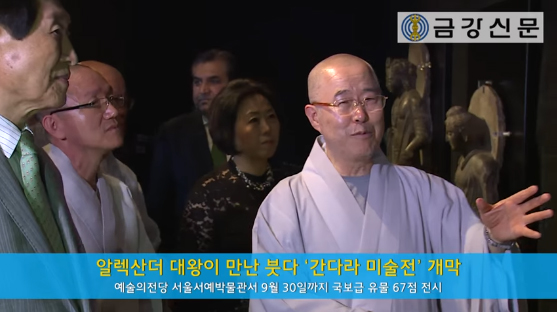 천태종. 천태종(총무원장 춘광 스님) 후원. 주한 파키스탄 대사관·페샤와르박물관·라호르박물관·예술의 전당 공동 주최. ‘알렉산더 대왕이 만난 붓다 - 간다라 미술전’ 개막. ‘카니시카왕 사리함’·‘부처님 고행상’·‘부처님 발자국 문양’·‘관음보살입상’ 등 파키스탄 국보급 문화재 67점 전시. 간다라 미술의 정수를 한자리에서 만날 수 있는 기회. 개막식 총무원장 춘광 스님·라힘 하야트 쿠레시 주한 파키스탄 대사·송종한 전 주 파키스탄 한국대사·고학찬 예술의전당 대표 등 100여 명 참석. 총무원장 춘광 스님 “이 전시회가 간다라 미술에 깃든 부처님의 가르침과 찬란한 예술성, 그리고 인류문화유산의 가치를 새롭게 인식하는 계기가 되길”. 예술의 전당 서울서예박물관. 06월29일부터 09월30일까지 전시. 불기2561년06월29일.
천태종. 천태종(총무원장 춘광 스님) 후원. 주한 파키스탄 대사관·페샤와르박물관·라호르박물관·예술의 전당 공동 주최. ‘알렉산더 대왕이 만난 붓다 - 간다라 미술전’ 개막. ‘카니시카왕 사리함’·‘부처님 고행상’·‘부처님 발자국 문양’·‘관음보살입상’ 등 파키스탄 국보급 문화재 67점 전시. 간다라 미술의 정수를 한자리에서 만날 수 있는 기회. 개막식 총무원장 춘광 스님·라힘 하야트 쿠레시 주한 파키스탄 대사·송종한 전 주 파키스탄 한국대사·고학찬 예술의전당 대표 등 100여 명 참석. 총무원장 춘광 스님 “이 전시회가 간다라 미술에 깃든 부처님의 가르침과 찬란한 예술성, 그리고 인류문화유산의 가치를 새롭게 인식하는 계기가 되길”. 예술의 전당 서울서예박물관. 06월29일부터 09월30일까지 전시. 불기2561년06월29일.
Click to view more detail
--------------------------------------------------------
GACA invited KBS producer to make documentry on Gandhara and beauty of Pakistan (Published in Dawn)
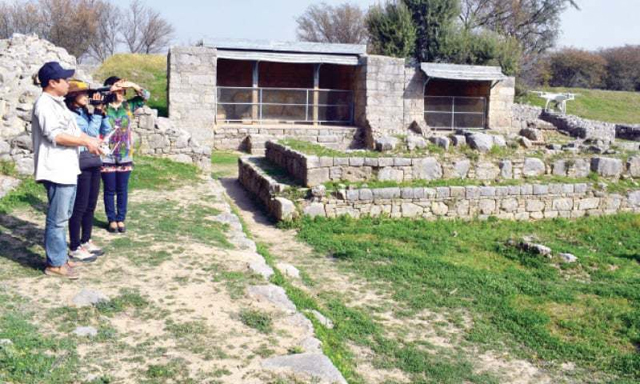 TAXILA: A two-member Korean Broadcasting System (KBS) team filmed various Buddhist sites of Gandhara civilization which they will air on South Korean official television .
TAXILA: A two-member Korean Broadcasting System (KBS) team filmed various Buddhist sites of Gandhara civilization which they will air on South Korean official television .
Lee Heon and Miss Hong, Eun Hee, producers of the KBS, are visiting the ancient sites on the invitation of Dr Esther Park, General Secretary, Gandhara Art and Culture Association (GACA).
Before coming to Taxila the KBS team also visited Lahore, Peshawar, Swabi, Swat and Gilgit and filmed various Buddhist sites.
"I have visited Sri Lanka, Thailand, China and Armenia to record various cultural sites but the potential and cultural diversity Pakistan harbours is unique and significant," said Miss Hong while talking to Dawn.
"What has really captured me about Pakistan is the kindness of the people here; really they are generous and hospitable," she added.
Replying to a query, she said it was her first visit to Pakistan and like other foreign media persons she had some misconception about Pakistan but after visiting various cities, she found it an enlightened and diverse country. "Through her documentary she will now show peaceful, tolerant and hospitable face of Pakistan to the world especially to Buddhists across the globe," she added.
Producer Lee Heon while talking to this reporter said that it was his 13th visit to Pakistan and every time he discovered a 'new Pakistan'.
He said earlier his documentary about various cities of Pakistan especially northern areas with the title "Beautiful Pakistan" was widely acclaimed by viewers in Korea.
Mr Lee, while answering a question, said that Monk Maranantha, credited for spreading Buddhist teachings across the Korean peninsula in the late 4th century AD, was originally from Chota Lahore in district Swabi, therefore Buddhist followers of Korea have deep-rooted spiritual and religious attachment with Pakistan and the documentary would further strengthen relations between the two countries.
Talking to this reporter Dr Esther Park said that Gandhara Art and Culture Association would organise an exhibition of Gandhara artifacts and sculptures in Korea in June.
She claimed that most of the Pakistanis might not be aware of the fact that South Koreans trace the roots of their Buddhist heritage to centers of Gandhara civilization located in Pakistan.
She said that through the exhibition the rich Buddhist archaeological treasure of Pakistan would be displayed in Korea.
Published in Dawn, March 21, 2017 :
Click to view
--------------------------------------------------------
Gandhara art exhibition to be orgainzed in Korea (Published in NNP)
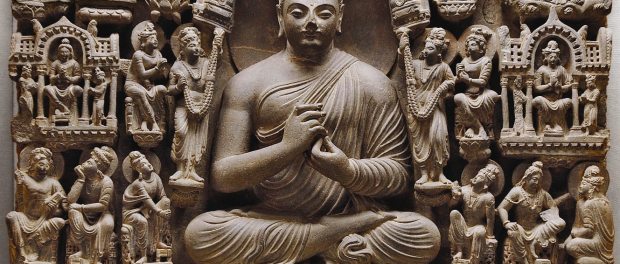 Gandhara art exhibition comprising of 68 art objects from Pakistan will be held in Seoul Korea starting end of March 2017. It will be held in ‘Buddhist central museum’ in the head quarter of Jo gye sect which is the biggest Buddhist sect in Korea. The exhibition would be organized by Gandhara art and culture association of Pakistan with collaboration with Interart channel and Jogye Buddhist sect. This was stated by Dr Esther Park secretary of Gandhara art and culture association while talking to newsmen here at Taxila Museum on Wednesday. Mr Yangsoo Kim president of Korean Interart channel was also present on this occasionThis exhibition will run for 6 months.
Gandhara art exhibition comprising of 68 art objects from Pakistan will be held in Seoul Korea starting end of March 2017. It will be held in ‘Buddhist central museum’ in the head quarter of Jo gye sect which is the biggest Buddhist sect in Korea. The exhibition would be organized by Gandhara art and culture association of Pakistan with collaboration with Interart channel and Jogye Buddhist sect. This was stated by Dr Esther Park secretary of Gandhara art and culture association while talking to newsmen here at Taxila Museum on Wednesday. Mr Yangsoo Kim president of Korean Interart channel was also present on this occasionThis exhibition will run for 6 months.
During this time many other cultural events will be organizedto promote the culture of Pakistan in Korea. She said that Gandhara art exhibition comprising of 68 antiquities taken from Pakistan will be held in Seoul Korea starting end of March 2017. She added that it will be held in ‘Buddhist central museum’ in the head quarter of Jo gye sect which is the biggest Buddhist sect in Korea. She said that this exhibition will run for 6 months. During this time many other cultural events will be organized to promote the culture of Pakistan in Korea. Mr Yangsoo Kim president of Interart channel said that the main objective of this exhibition is first of all to give a soft image of Pakistan and secondly to boost the tourism from Korea through Buddhist pilgrimage.
Published in NNP, December 15, 2016 :
Click to view
--------------------------------------------------------
Pakistan can become centre of attraction for Buddhists (Published in TheNews)
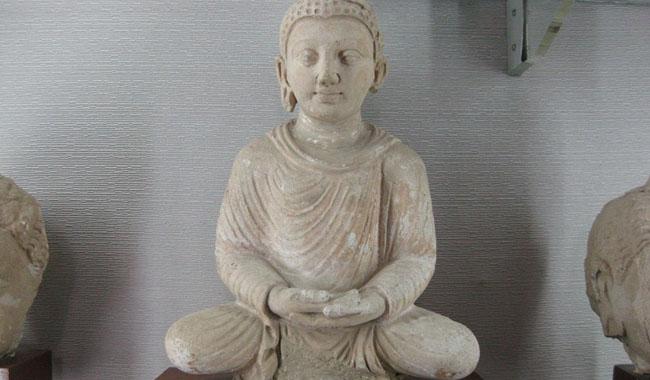 Islamabad: Pakistan has the tremendous potential for becoming centre of attraction for Buddhists as most of the Budh artefacts and ancient sites are based in the ancient Ghandhara region comprising Taxila, Mardan, Swat and areas in Hazara division, said Yang Soo Kim, President of Interart Channel of South Korea in an exclusive interview with The News.
Islamabad: Pakistan has the tremendous potential for becoming centre of attraction for Buddhists as most of the Budh artefacts and ancient sites are based in the ancient Ghandhara region comprising Taxila, Mardan, Swat and areas in Hazara division, said Yang Soo Kim, President of Interart Channel of South Korea in an exclusive interview with The News.
There are more than five hundred million followers of Budh religion around the world mostly in China, Korea, Japan and other far-eastern countries. These people bears a great reverence for these areas as a monk Maranantha from Chota Lahore near Swabi travelled via silk route to China and Korea in 384 AD and spread Budh religion in far-eastern countries.
Pakistan can receive millions of tourists annually if there may be peace and infrastructure in areas where these ancient sites and relics were located. If Pakistan government take the initiative, it could kick start a massive hospitality industry in the region earning billions of dollars foreign exchange annually.
Yang Soo Kim is the President of "Interart Channel" of South Korea who has been at a signing ceremony between the two countries under which agreement Interart Channel will be organising an exhibition of 68 art objects from Peshawar Museum in the Buddhist central museum that is a headquarter of Jogye the biggest Budh sect in Seoul, South Korea.
The agreement was signed on December 13 between National History and Literary Heritage Division Government of Pakistan and Korean Cultural Association. From Korean side Min Jeong president of said association signed the agreement. The exhibition will be held by the end of March 2017.
The exhibition of the artefacts from Peshawar Museum is an initiative of Interart Channel and Dr Esther Park secretary of Ghandhara art and culture association in Pakistan.
In discussion with Yang Soo Kim and Dr Esthar Park; they told this correspondent about the greatest significance of the ancient Ghandhara region for Budh community. They told that only few Buddhists who could travel to Pakistan and got a chance to visit these sites count themselves among the luckiest people, as this area is the birthplace of Budh religion. “Buddhists give great respect for this region. This region is sacred to Buddhists akin to Muslims who have great reverence for Makkah and Madina. Unfortunately there is no Budh Stupa in functional condition and if there may be a single one, Pakistan would be unable to cater the load of tourists that will hugely benefit the country’s economy.
Yang Soo Kim and Dr Esthar Park suggested that the way Pakistan is building economic corridor with China, similarly it could build a Korea-Pakistan Cultural Highway.
Published in TheNews, December 15, 2016 :
Click to view
--------------------------------------------------------
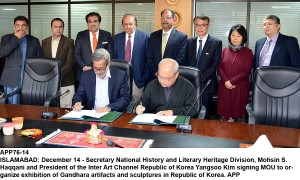 ISLAMABAD: December 14 - Secretary National History and Literary Heritage Division, Mohsin S. Haqqani and President of the Inter Art Channel Republic of Korea Yangsoo Kim signing MOU to organize exhibition of Gandhara artifacts and sculptures in Republic of Korea. APP
ISLAMABAD: December 14 - Secretary National History and Literary Heritage Division, Mohsin S. Haqqani and President of the Inter Art Channel Republic of Korea Yangsoo Kim signing MOU to organize exhibition of Gandhara artifacts and sculptures in Republic of Korea. APP
Published in APP, December 14, 2016 :
Click to view
--------------------------------------------------------
Dinner hosted for South Korean envoy (Published in DAWN)
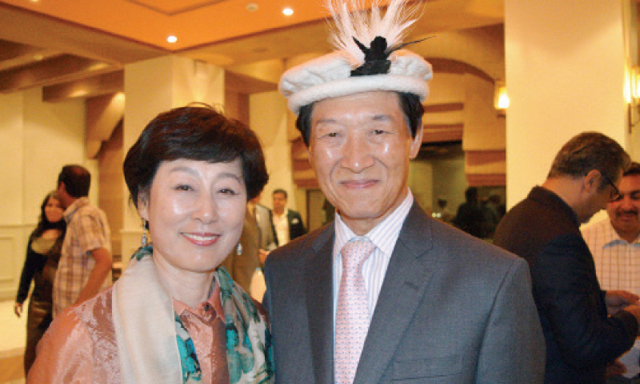 Ambassador of the Republic of Korea Dr Song Jong-hwan was hosted at a dinner at the Serena Hotel, held by the Gandhara Art and Culture Association.
Ambassador of the Republic of Korea Dr Song Jong-hwan was hosted at a dinner at the Serena Hotel, held by the Gandhara Art and Culture Association.
Dr. Kyo Soon Park, the coordinator of the association, hosted the evening alongside Imran Masood, the chairman of the association. Musicians from Gilgit and Hunza from the Sadoi-Pomir group performed at the dinner.
He spoke about how much he and his wife had enjoyed their three-and-a-half years in Pakistan, and said they travelled throughout the country – and visited Lahore in particular several times.
During the ambassador’s term in Pakistan, expansive cultural and commercial cooperation programmes between South Korea and Pakistan were established.
He said there is great potential for more Koreans to visit Pakistan’s Buddhist sites, since the religion’s history in Gandhara (southern Khyber Pakhtunkhwa) dates back some 2,300 years.
--Text and photo by Atle Hetland and Shahbaz Chaudary
Published in Dawn, May 8th, 2016 : http://www.dawn.com/news/1257026
--------------------------------------------------------
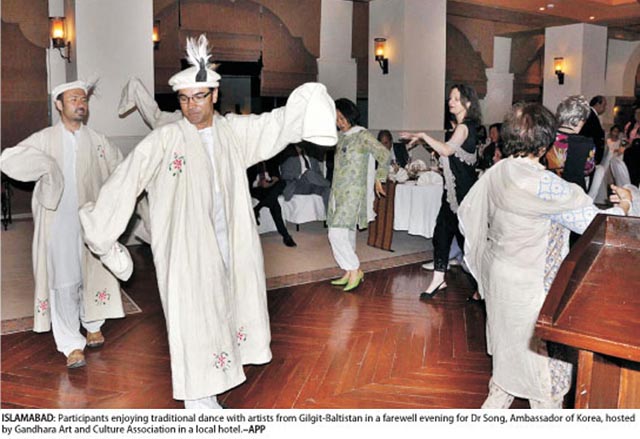
http://nation.com.pk/E-Paper/Islamabad/2016-05-02/page-13/detail-5
Korea Demands Budha Statues (GEO TV)
--------------------------------------------------------------------------------
Cultural exchanges can promote tourism: Korean envoy(Published in Dawn)
TAXILA: Enhanced exchanges can strengthen cultural ties between Pakistan and Korea and will also promote tourism between the two countries, said Korean Ambassador Dr Song Jong-hwan on Monday.
Talking to Dawn after an event hosted by the Gandhara Art and Culture Association, the envoy said he wanted to establish a “cultural highway” between the two countries to cement cultural relations, much like the motorway that was also built by the Koreans.
Other than enjoying friendly relations for a long time, Pakistan is also important to the Korea because it is the birthplace of Buddhism. Therefore, there should also be a cultural highway to bring the people of both countries closer, the envoy said.
He proposed an exhibition hosted in Korea each September and said that cultural exchanges will also enhance tourism between the countries and that more Koreans would like to come to Pakistan for religious reasons as well.
Though the countries have been enjoying friendly diplomatic and business relations for decades, the cultural ties between the two countries are almost 1,700 years old, he said.
The envoy said that the youth of Pakistan can change the fate of the country and that the younger generation must learn more about the work ethics which were adopted by the Korean youth in the past.
"I am convinced that Pakistan will achieve its own economic miracle, the miracle of the Indus River," he said.
Pakistan is an emerging market in the world and is blessed with a deep sea, a strategic location, natural resources and a talented younger generation which can bring a change, the envoy said.
Drawing a comparison with his own country, he added that Korea had fewer resources and is now considered one of the top economies of the world.
"This was possible because of the extraordinary sacrifice of the people of Korea and their work ethic," he added.
Pakistan is a developing country and its youth make up 35pc of its population, he said, adding that with the problems that Pakistan is facing, including terrorism, economic crisis, target killings and corruption, it is time for the younger generation to step up and address the problems of the country.
The ambassador also appreciated the Gandhara Art and Culture Association for promoting a promoting a softer image of Pakistan and for making efforts to holding art and cultural exchanges with various countries.
Published in Dawn, May 3rd, 2016
http://www.dawn.com/news/1255962
--------------------------------------------------------------------------------
Korean envoy for enhanced ties(Published in TheNews)
The Ambassador of the Korean Republic to Pakistan, HE Dr Song Jong-huwan, has termed Pakistan a beautiful country with very friendly and hospitable people with so many commonalities between the two and emphasised the need to build a 'Cultural' motorway like the M2 to extend and strengthen the friendly ties.
This was said by the ambassador, a highly educated diplomat with a PhD degree in Social Science’s discipline while talking to The News during his visits to The Lahore Museum, specially Gandhara Art Gallery and NCA on Thursday. He was received by Director of Lahore Museum. Accompanied by Dr. Kyo Soon Park, General Secretary Gandhara Art and Culture Association and its Chief Coordinator Zulfiqar Raheem, prominent artist Saeed Akhtar and Director Lahore Museum, Dr Song visited many sections of Gandhara Art Gallery. The Korean ambassador took a keen interest in the Fasting Buddha statue and other historic assets belonging to the Buddha religions. He pointed out that these great cultural assets preserved in the Pakistani museums have a great religious and cultural importance to the Buddhists all around the world, especially in Korea. He informed that besides being a long-time friend, Pakistan has a great significance to the Korean people in general and the Buddhists in particular since it is the birthplace and cradle of Buddha religion. Therefore, the Korean envoy maintained, like the motorway, which was built by the Koreans in Pakistan.
“We should also build a cultural highway to bring the two people closer. There is a great annual exhibition in being held in Korea this year in September and by cultural exchanges we can not only strengthen the cultural ties but can also promote tourism between the two countries tremendously since a lot of Koreans would love to come to Pakistan with regard to Buddhism's birthplace,” he said.
He said that youth of Pakistan can change the fate of the country and youth must learn the art of work ethics which were adopted by the Korean youth in past. The ambassador said: "I am convinced that Pakistan will achieve its own economic miracle, miracle of Indus River.
Pakistan is the emergent market of the world economy. Pakistan is blessed with deep sea, strategic location, natural resources and its talented youth that can change the fate of the country. Korea had fewer resources but now considered one of the top economies of the world. It is just because of extraordinary sacrifice of the people of Korea and their work ethics. Pakistan is a developing country and youth in Pakistan makes up about 35pc of its total population. In the midst of crunching times, when Pakistan is facing severe issues such as terrorism, economic crisis, target killings, corruption and disunity, besides intrigues and plots being perpetrated by anti-Pakistan forces to destabilise Pakistan, the burden to take the country out of the whirlpool is upon its young people.
The Korean Ambassador was presented souvenir by the Director of Lahore Museum. Later, the Ambassador visited National College of the Arts where he was received by the Principal NCA Dr Ali Jafferi. The Ambassador spent some time in the renowned art institution and visited an on-going exhibition about Pakistan Railways. The Korean Envoy admired the efforts of the teachers and the administration of NCA for promoting peace and mutual exchange between various countries through art.
http://www.thenews.com.pk/print/112722-Korean-envoy-for-enhanced-ties
--------------------------------------------------------------------------------
Korean envoy emphasises need to build 'cultural' motorway(Published in DailyTimes)
*Dr Song Jong-hwan says enhanced cultural exchanges cannot only strengthen cultural ties but can also promote tourism between the two countries
LAHORE: Pakistan is a beautiful country with extremely hospitable people, similar to that of the Korean Republic, said Ambassador of the Korean Republic to Pakistan Dr Song Jong-hwan.
He emphasised the need to build a “cultural” motorway, like the M2, to further extend and strengthen the friendly ties between the two countries.
He expressed this during his visits to the Lahore Museum, the Gandhara Art Gallery and the National College of Arts on Thursday.
Dr Song on the occasion was welcomed the Lahore Museum director, who was accompanied by Gandhara Art and Culture Association General Secretary Dr. Kyo Soon Park, Chief Coordinator Zulfiqar Raheem and prominent artist Saeed Akhtar.
Dr Song visited many galleries of the Lahore Museum during his visit. The worthy Korean ambassador took keen interest in the ‘Fasting Buddha’ statue and other historic assets belonging to the Buddhist religion. He pointed out that these great cultural assets preserved in the Pakistani museums have a great religious and cultural importance in Buddhism all around the world, especially in Korea.
He informed that besides being a long time friend, Pakistan is also of great significance to the Korean people, as the land is the birthplace of Buddhism. Therefore, the Korean envoy maintained, like the motorway, which was built by the Koreans, we should also build a cultural highway to bring the people of both countries closer. He said that an annual exhibition would be held in Korea in September and with enhanced cultural exchanges, we can not only strengthen the cultural ties but can also promote tourism between the two countries since a lot of Koreans would love to come to Pakistan for religious reasons.
The Lahore Museum director presented souvenir to the Korean ambassador. Later, the ambassador visited National College of Arts where he was received by NCA Principal Dr Ali Jafferi. The ambassador spent some time in the renowned art institution and visited an ongoing exhibition about Pakistan Railways.
The Korean envoy admired the efforts of teachers and administration of NCA for promoting peace and mutual exchange between various countries through art.
Korean envoy emphasises need to build 'cultural' motorway (dailytimes)
--------------------------------------------------------------------------------
Published in NawaiWaqt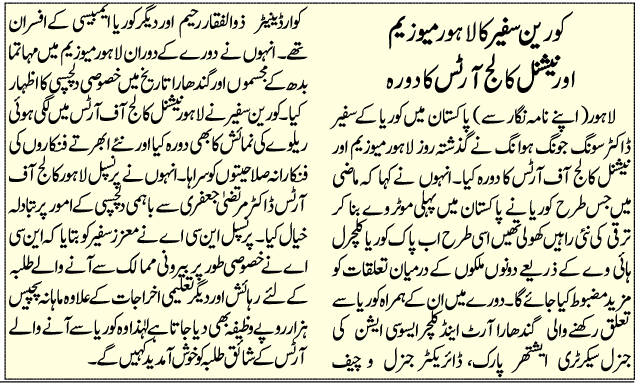
Click to view on Nawai Waqt
--------------------------------------------------------------------------------
Published in Tribune
Click to view on tribune
--------------------------------------------------------------------------------
In quest of Buddha in Pak
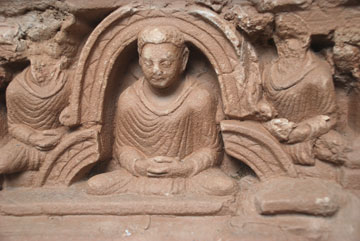 Call it absent-minded coincidence or Buddha’s grand plan, former journalist and author Sunita Dwivedi was born in Kushinagar where Buddha attained the Mahaparinirvana. From the tiny alcove of her room, she could see the huge cremation ground and Buddha’s statue loomed like a shadow.
Call it absent-minded coincidence or Buddha’s grand plan, former journalist and author Sunita Dwivedi was born in Kushinagar where Buddha attained the Mahaparinirvana. From the tiny alcove of her room, she could see the huge cremation ground and Buddha’s statue loomed like a shadow.
Perhaps that quirk of fate unwittingly decided Sunita’s quest – to seek Buddha, to walk on his footsteps, to find him around the world. No, Sunita is a not a Buddhist. She happens to love Buddha. And write about him – her fourth book on Buddha (Buddha in Central Asia; Rupa, Price: Rs 500; available on Flipkart) has just hit the stands.
Sunita clings to that moment when The Reclining Buddha at the Mahaparinirvana Temple lay calmly and uttered his last words to Anand, his disciple, ‘Decay is inherent in all composite things. Work out your own salvation with diligence.’ She never forgot these last words of the Reclining Buddha and started working towards her own salvation.
For that salvation – and for Buddha’s love – she has traveled to remotest corners and found Him – the bronze Buddha in Po Lin monastery, the giant Buddhas of Majishan, Buddhist rock edicts in Altyn-Emel, the Buddhist petroglyphs at Almaty…So many Buddhas in so many countries.
Her last stop: Pakistan, a region which in ancient days was the hub of Buddhism. But getting to Buddha there was fraught with danger and hurdles. Visa was the big question, but an invitation from Zulfiqar Rahim of Gandhara Art and Culture Association vanquished all visa frights. In four days, Sunita had the Pakistan visa in hand. Instead of flying, she decided to take the Friendship Bus from New Delhi to Lahore. Out went the jeans and trousers from her suitcase, Sunita threw in long kurtas, salwars and duppata.
With visa in hand, bags packed and an itinerary ready, she waited to step into Pakistan and find Buddha. Alone. But hell was breaking loose in Islamabad. Thousands of protestors were on the streets. Tear bombs were exploding and politicians were crying hoarse. Even nature was irate. Rivers were swelling and the fear of floods was staring hard. But nothing deters Sunita. Nothing. She knows Buddha will protect her. Everywhere.
In Lahore, her steps were hurrying towards Lahore Museum where lie the second century fasting Buddha image, a copy of the famous Kanishka casket and other antiquities of Gandhara art. It was in Gandhara that the artful depiction of Buddha’s life, earlier incarnations and mudras were first painted and sculpted. At Mandara village, stood a colossal stupa, perhaps built by Emperor Asoka in third century BC. Measuring 128 ft in diameter, the rubble-filled hemispherical stupa is embellished with lotus motifs on dressed stone. The stupa also marks the place where Buddha in his earlier life fed his flesh to a starving tiger.
Sunita was following the Buddha route — Taxila, Peshawar and Mardan. Taxila boasts of oldest and most important Dharamrajika Stupa which lies on the foothills of the Hathial spur. Peshawar had been the ancient centre of trade and learning. In Peshawar Museum lay several giant Buddha images in black, blue and grey schist excavated from various Buddhist sites in and around Peshawar.
Buddha seemed everywhere. A week in Pakistan and not for a moment did Sunita feel unsafe. All stories about Indo-Pak animosity seemed a myth. For her, Pakistan seemed like another home, the generosity of its people heart-touching. Sunita had traveled to Pakistan to find Buddha. She found him. She also found what Buddha preached – love and compassion. In the eyes of strangers who offered help; in the kind hospitality of Mian Imran Masood who welcomed her home and offered tea; in the kindness of Zulfiqar Rahim and his wife Dr. Kyo Soon Park; the benevolence of Ayesha M Hamid. In Pakistan, Sunita knew no fear. She found Buddha. And the love of its people.
Source: http://www.indiapost.com/in-quest-of-buddha-in-pak/
Coming back to life: Buddhist songs resound in Jaulian monastery after 1,500 years [The Express Tribune, October 23rd, 2014]
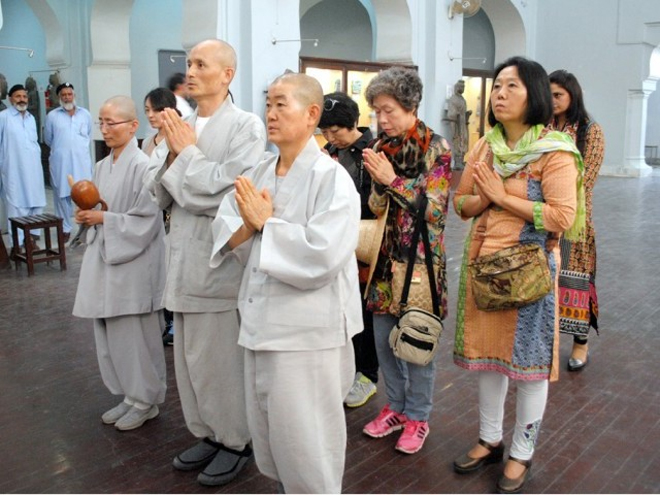
HARIPUR: For 1,500 years the place was almost silent, with only the occasional sounds of visitors’ footsteps and rustling leaves filling the air. Earlier this week, however, Jaulian monastery came alive with the songs of Buddhist monks for the first time since it was destroyed in the 5CE by the White Huns.
A prayer ceremony for peace was arranged by the Khyber-Pakhtunkhwa (K-P) Directorate of Archeology at one of the most prominent Buddhist sites in the country. The ritual started at sunset and monks from South Korea made offerings of incense, light, water, flowers, fruit and rice.
The incense symbolises the pure and moral Buddha, light denotes wisdom and drives away the darkness, water results in clarity and leads to purity, while flowers not only bring freshness and fragrance but also reflect the ephemeral nature of all things, including humans. Fruits signify enlightenment, while rice or food offerings symbolise freedom from hunger so that mind, body and spirit can function to achieve the perfect state. Following the offerings, monks circumambulated the main monastery and the subsidiary stupa.
Jaulian monastery is among the prominent heritage sites of the province and located close to Taxila. Sir John Marshall, director of the Archaeological Survey of India (1902-28), in his book Guide to Taxila noted the monastery is at the top of a hill close to the village of Jaulian. Marshall said there was reason to believe that the destruction of the Buddhist settlement took place in 5CE at the hands of the invading Huns.
There were a total of eight visiting monks, including two women. After the prayers, chief monk Han Soon Ae told reporters he was most content after visiting and praying at the monastery. “It was an enlightening experience,” he added.
K-P Director Archaeology and Museums Dr Abdul Samad told The Express Tribune the aim of the event was to portray a soft image of K-P and promote the region through religious tourism, which authorities had been striving to achieve.
He said the directorate sponsored the visit and the monks would also go see the Peshawar Museum and Buddhist sites in Takhta Bhai and Swat. He highlighted this was the first religious service held at Jaulian since its destruction.
Samad added one of the objectives of the visit was to reestablish ancient links between the regions as Buddhism spread to Korea from ancient Ghandhara.
Among those attending the ceremony were Opposition Leader in the Senate Chaudhry Aitezaz Ahsan, senior Pakistan Muslim League-Nawaz (PML-N) leader Salim Saifullah Khan, former foreign minister Gohar Ayub Khan and others.
Published in The Express Tribune, October 23rd, 2014.
http://tribune.com.pk/story/779389/coming-back-to-life-buddhist-songs-resound-in-jaulian-monastery-after-1500-years/Zee New Wednesday, October 22, 2014
Buddhist monks pray at Peshawar museum for world peace
The Nation, Wednesday, October 22, 2014
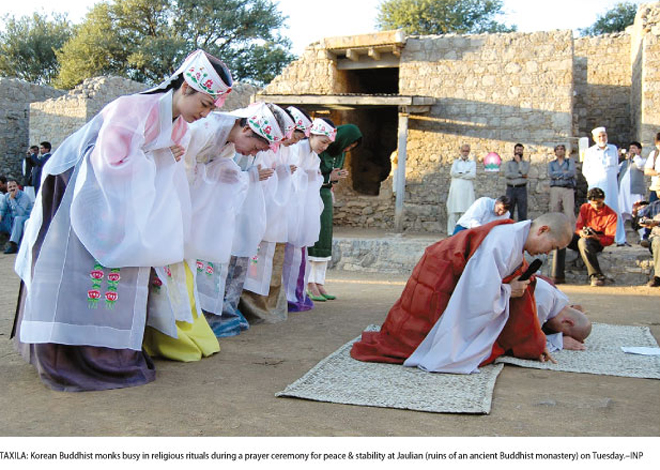
http://nation.com.pk/E-Paper/islamabad/2014-10-22/page-13
GACA director Dr Prof Iqbal Chawla article in Indian newspaper
India Post: September 26, 2014 [Click to download article]
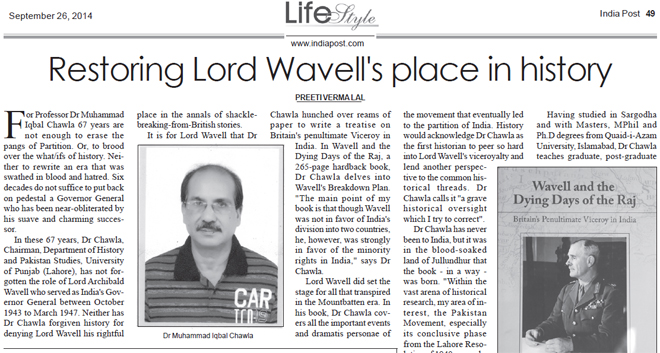
Down, Islamabad: July 19, 2014
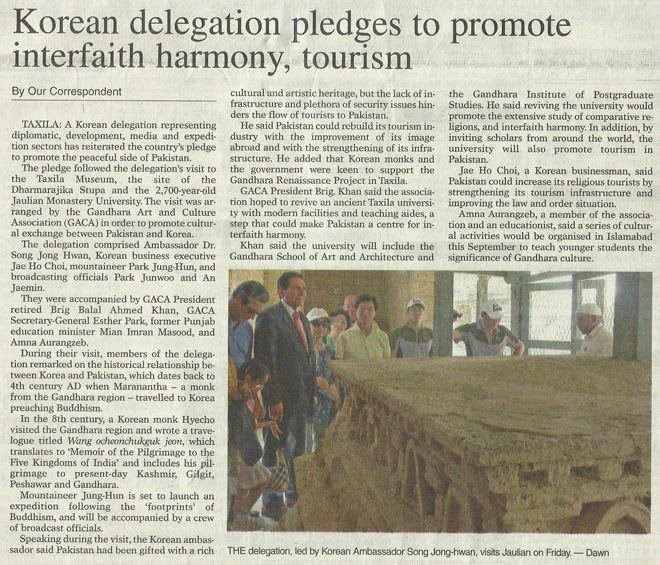
Lessons from S Korea: Pak govt must take greater responsibility
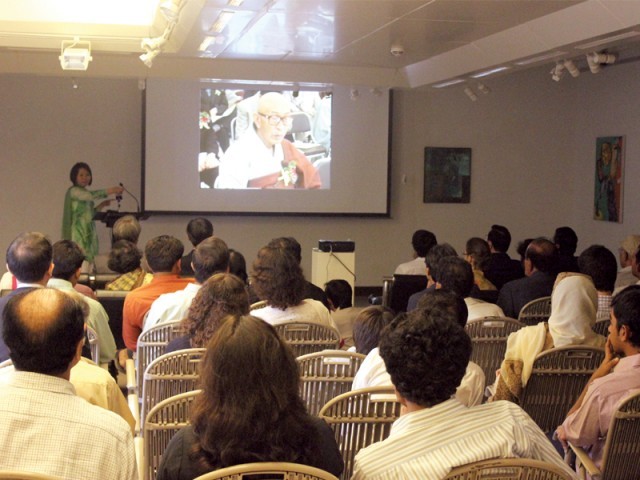 ISLAMABAD: Over a decade after it was revealed that the monk who introduced Buddhism to Korea centuries ago belonged to a town in Khyber-Pakhtunkhwa, ancient Buddhist remains in the town continue to be ignored by the local authorities. Monk Maranantha, credited for spreading Buddhist teachings across the Korean peninsula in the late 4th century CE, hailed from Chota Lahore in Swabi district, according to Dr. Kyo Soon Park, founding member of the Gandhara Art and Culture Association Read Full
ISLAMABAD: Over a decade after it was revealed that the monk who introduced Buddhism to Korea centuries ago belonged to a town in Khyber-Pakhtunkhwa, ancient Buddhist remains in the town continue to be ignored by the local authorities. Monk Maranantha, credited for spreading Buddhist teachings across the Korean peninsula in the late 4th century CE, hailed from Chota Lahore in Swabi district, according to Dr. Kyo Soon Park, founding member of the Gandhara Art and Culture Association Read Full
Swabi has a sister city in S. Korea
TAXILA, April 14: The South Korean city of Yeonggwang and Swabi City of Khyber Pakhtunkhwa (KP) would be declared sister cities, and a letter of intention would be signed during the week in this regard between the KP government and Yeonggwang city council. Read Full
Gandhara – an unutilized asset of Pakistan
Wednesday, December 19, 2012 - Islamabad—Few Pakistanis are aware that Gandhara art and culture is exceptionally attractive for millions of foreigners in East and West; and Pakistan can earn millions by promoting this historic site. To highlight the significance of the remarkable centuries-old civilization, Gandhara lovers gathered on Tuesday in Islamabad at Pakistan National Council of Arts (PNCA) and reiterated their deep Read Full
Preserving the past
ISLAMABAD, Dec 18: It is the responsibility of the government to look after its cultural heritage sites and through education keep the nation attuned with its past. This was the general perception of the participants at a lecture The Unique Cultural Heritage of Gandhara organised by Gandhara Art and Culture Association at Pakistan National Council of the Arts (PNCA) on Tuesday. Read Full
Lecture on 'Unique Cultural Heritage of Gandhara' on Dec 18
ISLAMABAD, Dec 16 (APP): Gandhara Art and Culture Association and Oxford University Press will arrange an awareness lecture on ‘The Unique Cultural Heritage of Gandhara’ and launching ceremony of the book ‘Wavell and the Dying Days of the Raj’ by Muhammad Iqbal Chawla on December 18 (Tuesday). Read Full
파키스탄 정부 장관 및 고위관계자 영광방문
 파키스탄 간다라지방의 카이버박툰카와(KPK) 정부의 관광과 고고학 그리고 박물관을 총괄하는 장관을 포함한 고위인사들이 동북아시아에 대승불교를 전파한 자신들의 선조인 마라난타 스님의 숨결이 살아 숨쉬는 영광 법성포 간다라박물관과 불갑사를 1박2일 일정으로 방문했다.
파키스탄 간다라지방의 카이버박툰카와(KPK) 정부의 관광과 고고학 그리고 박물관을 총괄하는 장관을 포함한 고위인사들이 동북아시아에 대승불교를 전파한 자신들의 선조인 마라난타 스님의 숨결이 살아 숨쉬는 영광 법성포 간다라박물관과 불갑사를 1박2일 일정으로 방문했다.
대승불교와 불교 예술의 발상지면서 동서양 문화와 종교가 융합했던 파키스탄 고위 인사들이 서기 384년 백제 침류왕 초청으로 백제불교를 열었던 마라난타 스님의 유적지인 영광을 방문하기는 1628년만의 일이다. Read Full
“영광 불갑사에서의 템플스테이 종교간 화합의 첫 사례다”
셰드 아킬 샤 카이버박툰카와/파키스탄 관광부장관
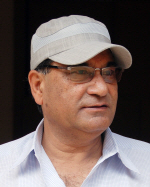 셰드 아킬 샤(Syed Akil Shah) 카이버박툰카와 관광부장관은 이번 내한에 대해 “중국, 몽고, 영국, 러시아, 미국 등 열강들의 각축장 여파로 파괴된 찬란했던 고대 불교 유적지를 복원해서 문화와 문명국가로 거듭나기 위한 파키스탄 정부의 의지다”면서 “간다라지방 출신인 마라난타 스님이 꽃피운 한국 불교를 보고 다시 고향인 간다라에 불교 유적지 복원을 통해 동서문화와 문물이 1천년동안 꽃피었던 시절의 평화와 세계 문명의 종주국 역할을 회복하기 위한 첫 걸음이다”고 밝혔다. Read Full
셰드 아킬 샤(Syed Akil Shah) 카이버박툰카와 관광부장관은 이번 내한에 대해 “중국, 몽고, 영국, 러시아, 미국 등 열강들의 각축장 여파로 파괴된 찬란했던 고대 불교 유적지를 복원해서 문화와 문명국가로 거듭나기 위한 파키스탄 정부의 의지다”면서 “간다라지방 출신인 마라난타 스님이 꽃피운 한국 불교를 보고 다시 고향인 간다라에 불교 유적지 복원을 통해 동서문화와 문물이 1천년동안 꽃피었던 시절의 평화와 세계 문명의 종주국 역할을 회복하기 위한 첫 걸음이다”고 밝혔다. Read Full
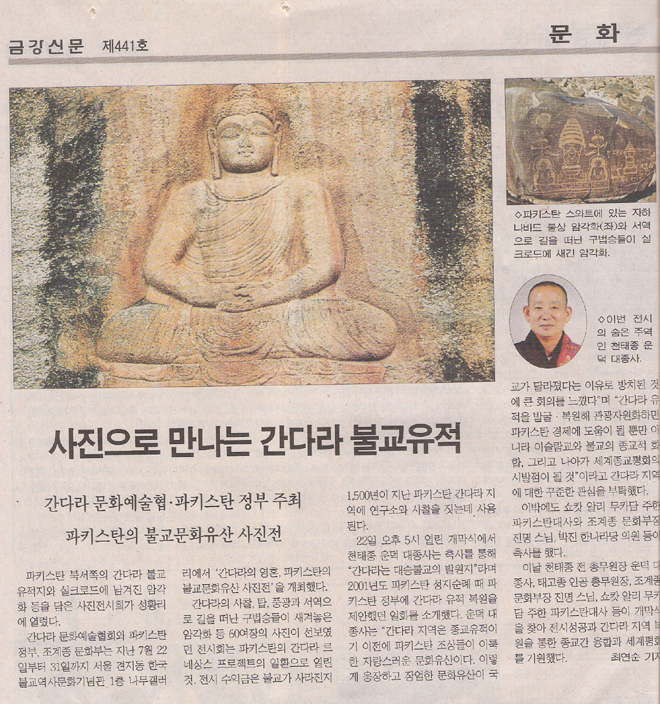
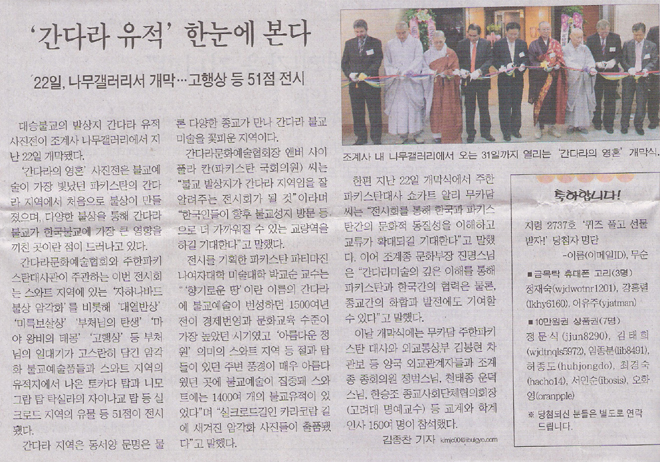
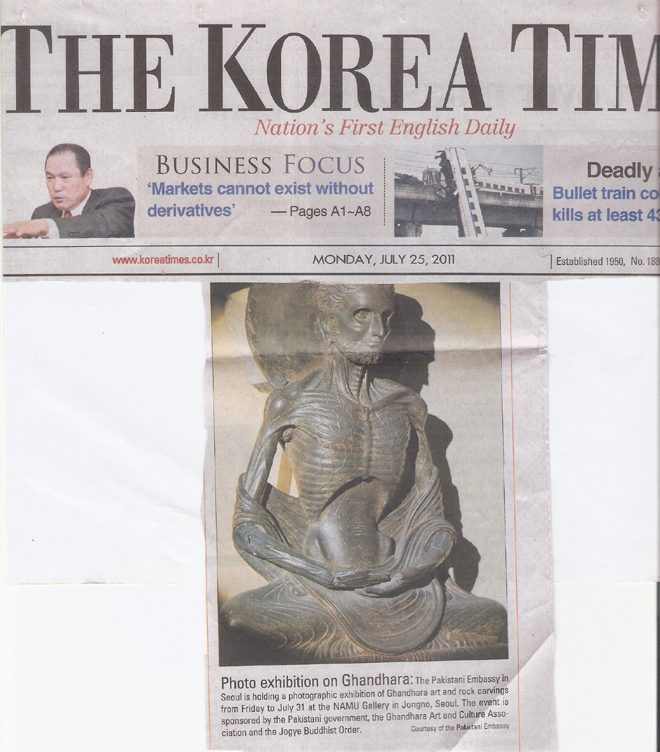
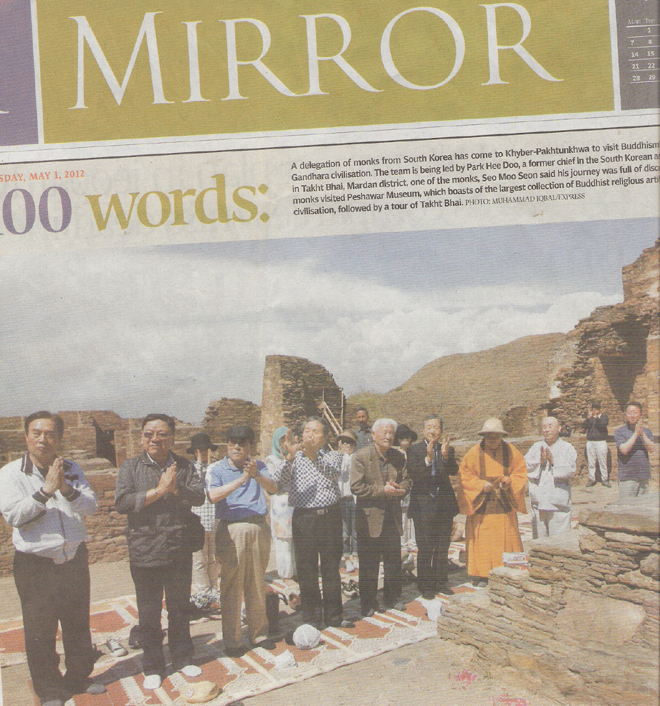
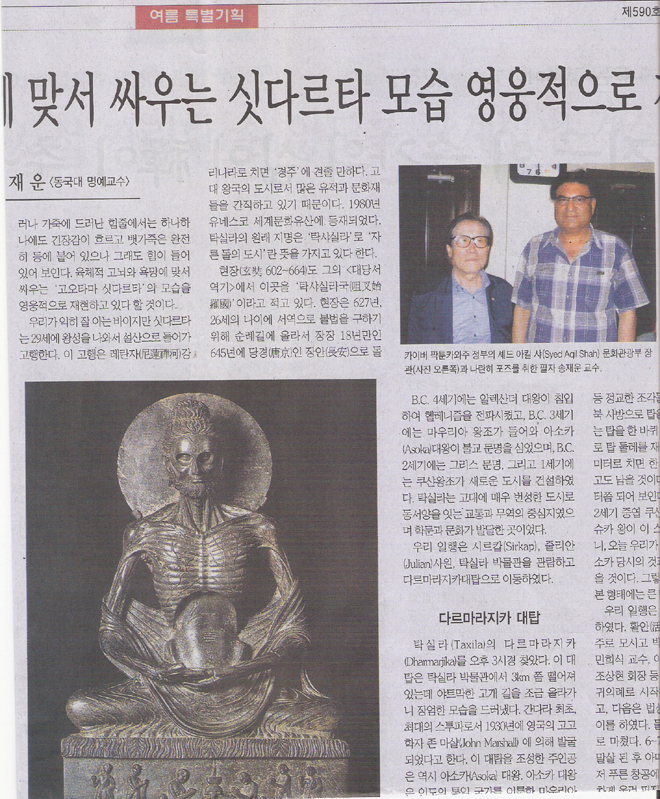

















 Home | About Us | Gandhara Renaissance | Venerable Monk Speech | Events & Activities | Contact Us
Home | About Us | Gandhara Renaissance | Venerable Monk Speech | Events & Activities | Contact Uswww.gandharaartandculture.org © All Rights Reserved 1998-2025

